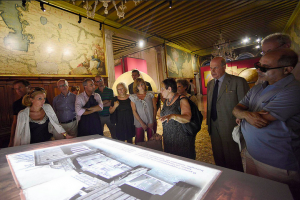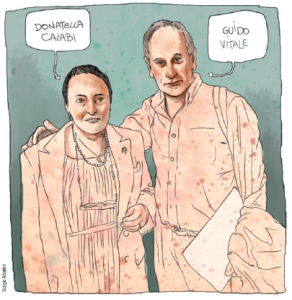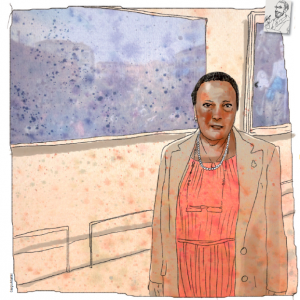VENICE AND THE GHETTO “A Journey inside My Very Special City”
In Venice for the first time, two American students get off the train and look around. Then, they spot Donatella Calabi who is a tenured professor of history of the City and Territory at the prestigious University Institute of Architecture in Venice. By chance they stop her and ask, “Excuse us, is there anything else here to see, other than that the big San Marco square?” Professor Calabi, has devoted her whole life to studying the complexity of Venice and the structure of Italian cities. Patiently, she begins to explain that yes, there is a lot more to see for all those who really want to get to know the city on the water.
In the meantime, many people join the line to enter the Doge Palace, some of them very aware of where they are, others there almost by chance. Some stop while walking down the famous Riva degli Schiavoni on the scorching pavement of one of the most celebrated squares in the world.
The Palace embodies the symbol of power of the Serenissima, as the Republic of Venice was once known. It is currently the venue of an unforgettable exhibition, “Venice, the Jews, Europe. 1516-2016,” curated by Calabi. The exhibition is devoted to the five centuries since the establishment of the first ghetto in history. The itinerary through the spectacular halls of one of the most fascinating buildings in Venice stuns the visitor. The exhibit shows the visitor the rigorous historical reconstruction of what the ghetto was, what it became later, and also a reflection on the identity of the city. It is lesson to understand how urban space developed and on the issues of integration and segregation. It reveals as well the richness of the coexistence of different, and seemingly at first irreconcilable cultures. The exhibition offers a lesson of history and urbanism which unites rigor and passion to a place that is unique in the world, with its secular vicissitudes indissolubly tied to the destiny of the Jews who have always lived there and still do.
Everyone wants to visit Venice, but very few fully understand it. What does this city truly represent? An alternative world, a unique place that belongs to a different reality, or a model which helps us to understand the destiny and potential of Italian cities?
Venice is above all a city. It is a very special one, as determined by the difficulties and environment of the lagoon it stands on, surrounded by water and by natural factors that are well known. It might be different and incomparable to any other city, but it still remains a city. Its specific physical and geographical traits do not make it less of a city.
 How did your research on Venice get started?
How did your research on Venice get started?
I had worked a lot on the development of the merchant stalls that constituted the heart of the city. I studied issues such as how space was organized and the attempts to discipline exchanges and behavior. Venice’s development is original, but between the 15th and 17th centuries, it had a similar growth pattern as that of other great merchant cities: Antwerp, Seville, London, Paris.
Does understanding Venice therefore provide tools to better understanding he development of other cities?
I believe that the example of Venice provides interesting insights into the problems that many cities face.
Where to start in order to understand if someone is not an expert, but at the same time wants to avoid mass tourism?
First of all, I recommend a book by archeologist and historian Salvatore Settis called Se Venezia Muore (If Venice Dies). I think by reading it, one can see clearly how Venice is both the emblematic and the extreme case of what a city is today, and what are the limits and the threats are to a historical city center. In this perspective, Venice is definitely a symbol.
In the past weeks, the meaning of the cultural initiatives connected to the 500th anniversary have been widely discussed and different perspectives have emerged. Some have expressed their dissatisfaction with some of the events that may have appeared as an unintentional celebration of a dark page of Jewish history; the one of forced segregation. The exhibition highlights a more nuanced interpretation. How can we interpret the establishment of the ghetto?
Venice is a place of pluralism. This is what the long history of the ghetto teaches us. Its establishment shows the will, right or wrong, to organize the city. Foreigners and minorities were necessary for the growth of the Republic, and Venice found its way to have different needs coexisting in the same space. For sure my take on the ghetto’s vicissitudes is not conventional. However, I believe that evoking the ghetto of Warsaw when speaking about the ghetto of Venice is neither right nor useful. Nor do I believe it helps to solve the problems of integration and separation that we find ourselves faced with today.
 Is not the model of the ghetto of Venice, the first ghetto in history applicable anywhere else?
Is not the model of the ghetto of Venice, the first ghetto in history applicable anywhere else?
The case of Venice is very different from the ghettos in Rome, Florence, Siena or Modena. They were built on Italian territory over the course of 30-50 years. We Italians have the opportunity to study why the model of Venice was so very advanced. The Ghetto of Venice was clearly a model of a city within a city; an internally organized microcosm.
The Campo di Ghetto Nuovo is a place for the preservation of identity. Padua or Modena never fully succeeded in the same experiment. The Jewish movements in the Mediterranean with Venice as a base allowed the exporting of concepts and thinking on the issue of organizing a city. The vicissitudes of the Ghetto derive from the willingness to organize the city. The expulsion of the Jews from the Rialto market was an expression of separation but also of organizing new commercial space in the city.
In the past months, the results of some important rounds of voting, from local elections in major Italian cities, to the British referendum on Brexit, have been read as the mark of a geographical differentiation of opinion, with a contraposition of urban and rural areas. Cities where sometimes the hardships are the most intense, are they still a laboratory of innovation in society?
Cities, especially capital cities, are places of innovation and new experiments. I cannot share the idea that cities are necessarily places of suffering. Historically, people in urban areas have always lived better than those in the countryside. However, to generalize is obviously wrong.
Venice, the Jews, the Ghetto. The exhibition at the Doge Palace also gives one the opportunity to reflect on a city that was once great and on a Jewish city within the general city. However, considering the Venice of today, threatened, sieged, and becoming more and more depopulated; it is also useful to think about what makes a city: would the number of current residents today classify Venice as a small town? The way the space of the city is organized? The ability to create culture?
Real cities are not only the number of their residents. They are a project, a policy for the territory, a network of services, a sum of different opportunities and models. They are the richness of the plurality of these models, of ideas and of responses to daily problems. Cities are measured by the diversity they manage to include and by the options they offer. Italy, at closer look, is a nation of small centers that we call full cities, not because of their population, but because of the richness of their infrastructure, services, and exchanges, all of which make them great. I think about cities like Mantua, Ferrara, Urbino, Siena and many others. The model of Italian cities still has much to offer to the world.
You are referring to the geography of the “Italia dei Comuni”, the very same geography that for centuries has characterized the identity of Italian Jews and the location of the 21 Communities that today represent the Jewish presence in Italy.
The video that welcomes visitors to the exhibition in the Doge Palace particularly features the migration of the Jews throughout the Mediterranean area. The cities with a Jewish presence mirror the geography of these cities. The city of everyone, and the city of the Jews, with all the difficulties, progress and uncertainties share a common faith that cannot be separated.
*This interview was published in the August issue of Pagine Ebraiche. The artwork is by Giorgio Albertini, the picture is by Giovanni Montenero.

